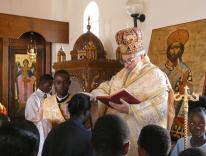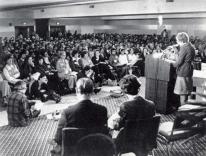The pregnant body is indeed “theology in motion,” as Laura S. Jansson writes in her book, Fertile Ground: A Pilgrimage through Pregnancy. She uses this phrase to describe her own experiences as a pregnant woman, but it is surely true in a grander sense for the Christian tradition: God came into the world not in the blink of an eye, but in and through his mother’s womb—through the process of pregnancy, labor, and delivery. Just like the rest of us.
For a tradition that literally begins in the body of a mother, Christianity has dedicated remarkably little theological reflection to the experience of pregnancy. Fortunately, as the title of Jansson’s book suggests, there’s no dearth of material. Though marketed to expectant mothers—to whom it will be an especially valuable resource—Jansson’s work is also a boon for anyone interested in thinking deeply about pregnancy, birth, the embodied experience of being human, and the deeply Christian mysteries of life and death.
Fertile Ground is designed to follow the week-by-week progress of a pregnancy. I read it in one sitting, which I do not recommend. It was like eating a box of one’s favorite truffles all at once. Much better to spread it out over the months of a pregnancy and savor each chapter one at a time. That being said, no one should be discouraged by the book’s format. An expectant mother can acquire the book at any stage of her pregnancy, begin reading at the relevant week, and feel free to go back later and dip in and out of previous chapters. Others might do well to simply read it more slowly than I did.
Jansson brings a unique combination of professional training and life experience to bear on this book. She has a masters’ degree in theology and philosophy from Oxford University, and is an Orthodox Christian doula, a childbirth educator, and a mother. She has also lived in an unusual variety of settings, including the United States, the United Kingdom, Serbia, Germany, and Fiji. This background makes for a book that avoids the saccharine sentimentality that pervades much of Christian writing about motherhood, admirably balancing theological sophistication with accessibility and demonstrating an unusual level of cross-cultural sensitivity.
Jansson joins a growing number of women within the Orthodox Church who are thinking theologically about motherhood, and what she has to offer is significant. Take Chapter 14, titled “Links”—one of my favorite parts of the book. Starting with the way a pregnant woman’s bellybutton changes during pregnancy, Jansson goes on to discuss, among other things, St. Symeon the New Theologian’s advice for praying the Jesus Prayer with the omphaloskepsis (literally “navel-gazing”) method, the physical connection of umbilical cord between mother and child, the genealogy of Christ, and, finally, the icon of the foremothers of Christ, in which Christ and three generations of his maternal ancestors are nestled, one inside the other.
It is still unusual, even now, to find Scripture quoted and interpreted in the context of pregnancy and giving birth. Jansson’s elucidation of John 16:20–22 is fresh and illuminating. She explains that, at first, it seems that Christ is simply explaining to his disciples that “at His death they will experience an all-consuming grief, like the anguish of a laboring woman.” Yet, as Jansson explains, Christ is also connecting the laboring women’s birth experience with his own Resurrection: “Both Christ and the birthing mother bring forth new life, but through pain and sacrifice. Our species is perpetuated only on the brink of annihilation. It’s striking that Christ chose to describe Himself using such an explicitly feminine metaphor.” After a brief comparison of translation issues, Jansson concludes, “Christ tells us that just as a baby comes forth from his mother, joy is born from pain. Joy is blissful not despite the adversity, but because of it. Resurrection comes not just after death, but through it.” She adds that this rings true for her own experience of labor, delivery, and the postpartum body. This sort of deep investigation of the biblical text with an eye for social and maternal themes reminds me of the fantastic work of Beverly Roberts Gaventa on the maternal imagery of Apostle Paul. It also makes me wish Jansson would extend her work beyond this guidebook. Because it has been structured and marketed as a book for pregnant women, it will likely remain largely confined to that readership, no matter how much one encourages others to read it.
I doubt Jansson intended her book to be radical or revolutionary, but it is at the very least strikingly original. For example, her use of “foremothers” to refer to women who have come before us within the tradition is technically correct and not exactly controversial. But within the context of Orthodox Christianity—in which “patriarchy” is a word with positive connotations (in the Orthodox Church “patriarchs” are the head bishops of synods) and the Church Fathers reign supreme (the next time someone drops the phrase “and the Church Mothers,” see if they can name one)—“foremothers” lands in a certain way. No complaints from me. On the contrary, I feel that the book was weakest when Jansson shies away from acknowledging just how innovative her own project is, or from lamentable aspects of Orthodox praxis concerning pregnancy and motherhood. While her chapter on the Orthodox prayers used when a mother returns to church forty days after delivery does acknowledge that these prayers describe the new mother as “impure” or “defiled” by childbirth, Jansson seems more comfortable with finding ways for new mothers to deal with their reactions to this language than with placing the onus where it rightfully belongs: on the Orthodox Church itself. These theologically indefensible and pastorally harmful prayers should be overhauled as soon as possible. (Jansson does mention that one jurisdiction has begun to offer alternatives.)
But at many other points, Jansson is willing to examine sensitive matters. A whole section of the appendix is dedicated to miscarriage. Given the frequency of miscarriage and the fact that it often goes unmentioned in books about pregnancy and birth, this is an especially important feature of the book. Jansson also discusses, without undue pudeur, the visceral realities of pregnancy, making good use of her experience as a doula. Perineal tearing, lochia, labor pain, the changing postpartum body—all these things are addressed with real love and care, and with theological sensitivity. This is my favorite quality of Jansson’s book: the way she has constructed it to accurately reflect the total experience of expecting another human being. She brings it all—intellect, soul, and body—together in Fertile Ground in a way that rightfully and beautifully honors the “theology in motion” that is pregnancy.
Fertile Ground
A Pilgrimage through Pregnancy
Laura S. Jansson
Ancient Faith
$18.95 | 320 pp.
Please email comments to [email protected] and join the conversation on our Facebook page.
Previous Story
Hard-Won Wisdom
Next Story
‘Lived from the Heart’

